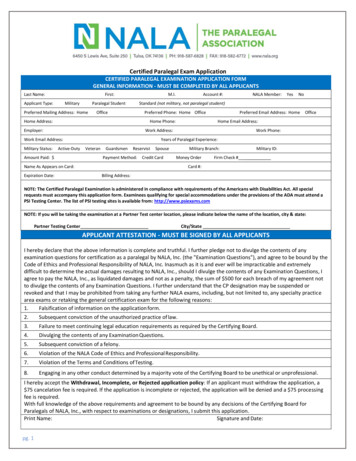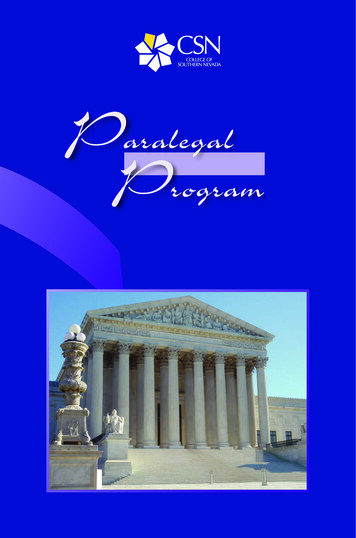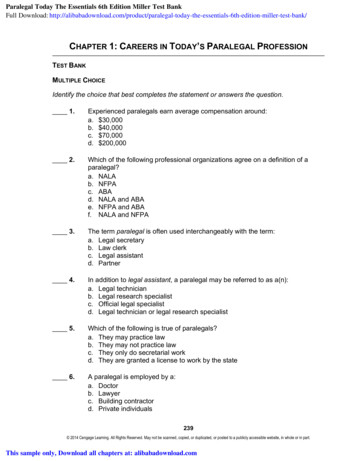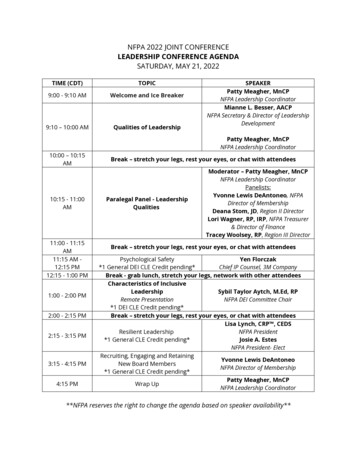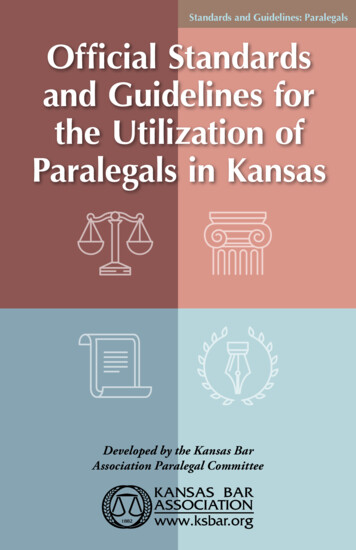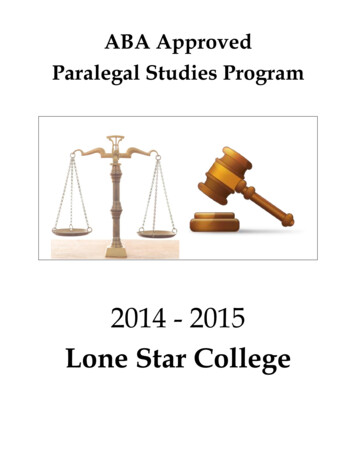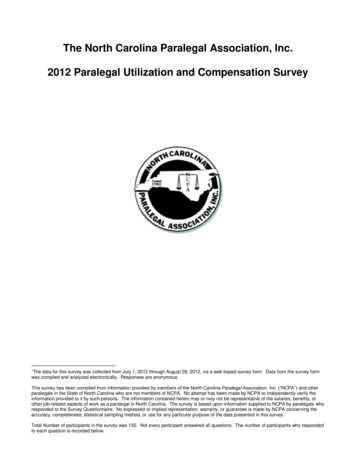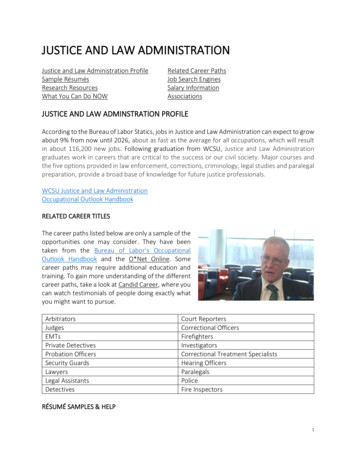
Transcription
Jointly published by the Paralegal Advisory Service Institute (PASI)and Penal Reform International (PRI)Penal Reform Internationalwww.penalreform.orgParalegal Advisory Service Institutepasi@sdnp.org.mwPASI & PRIADL HousePO Box 30311Lilongwe 3MalawiISBN: 978-0-9535220-4-0
THEPLC MANUALA MANUAL FOR PARALEGALS CONDUCTINGPARALEGAL AID CLINICS (PLCs) IN PRISONSecond edition2007
Nanzikambe is the leading arts-based development organisation in Malawi. The organisation’s bodyof work in Malawi and the region encompasses producing and touring innovative theatre for Malawianand international audiences; and using theatre for education, development and social change.Nanzikambe’s artistic initiative includes adapting classics for the African setting and unearthing yet-untold stories anddevising theatre that touches the heart of contemporary issues in society. Nanzikambe is committed to training versatileperformers and theatre-makers and raising industry standards. The organisation’s development work is concerned with socialchange, firmly believing in the crucial role that culture can play in poverty reduction. This work includes: training facilitatorsand educators in inter-active communication methods; providing forum theatre performances for potent message delivery,human rights advocacy and behaviour change; community mobilisation, producing written materials to enhanceunderstanding of the use of theatre as an effective tool for education and development, developing interactive media forradio and television.Since 2002, Nanzikambe has worked with paralegals in Malawi and Kenya to develop their approach to conducting ParalegalAid Clinics (PLCs) in prisons. Nanzikambe has designed a tailor-made training course and rewritten this PLC Manual toinclude forum theatre and interactive learning methodologies.Contact: info@nanzikambe.org; www.nanzikambe.orgPenal Reform International (PRI) is an international NGO founded in 1989 with consultative statuswith the United Nations and the Council of Europe and observer status with the African Commission onHuman and Peoples’ Rights.PRI seeks to achieve penal reform while recognising diverse cultural contexts by promoting:the development and implementation of international human rights instruments with regard to law enforcement, prisonconditions and standardslthe elimination of unfair and unethical discrimination in all penal measureslthe abolition of the death penaltylthe reduction of the use of imprisonment throughout the world; andlthe use of constructive non-custodial sanctions which encourage social reintegration while taking account of theinterests of the victimslPRI has its central office in London with regional offices in Amman (North Africa and Middle East), Almaty (Central Asia),Bucharest (Central and Eastern Europe), Kigali (Great Lakes), Lilongwe (Central, Eastern and Southern Africa), Moscow(Eastern Europe), Tbilisi (South Caucasus) and Washington (the Americas).Contact: www.penalreform.orgParalegal Advisory Service Institute (PASI)The Paralegal Advisory Service (PAS) started in Malawi in May 2000 as an initiative of PRI todevelop a public/private partnership between four Malawian NGOs and the Malawi Prison Service, toprovide legal education, advice and assistance to prisoners. From 2003, the PAS expanded its servicesfrom prison to police and court. In 2004, it received a UN-Habitat Good Practice Award. In 2007, the PAS, as supported byPRI, has evolved into the autonomous PAS Institute (PASI). The PASI is taking over the management of the PAS programmein Malawi and will act as a resource for training of paralegals in Malawi and abroad, as well as expertise for further regionaland international development. Contact: pasi@sdnp.org.mwIn Malawi, the PASI partners are: Youth Watch Society (YOWSO: pas-yowso@sdnp.org.mw), Centre for Legal Assistance(CELA: pas-cela@sdnp.org.mw), Malawi CARER (pas-carer@sdnp.org.mw) and the Centre for Human Rights, Education,Advice and Assistance (CHREAA: pas-chreaa@sdnp.org.mw).In Kenya, the Kenya Prisons Paralegal Project (KPPP) is co-ordinated by the Legal Resources Foundation (LRF) of Kenya.Contact: info@lrfkenya.orgIn Uganda, the PAS (Uganda) is co-ordinated by the Foundation for Human Rights Initiative (FHRI).Contact: fhri@spacenet.co.ug2In Benin, the Programme d’Assistance Judiciaire aux Detenus (PAJUDE) is a partnership between the Ministry of Justice,Legislation and Human Rights and Prison Fellowship Benin, Centre Afrika Obota and the Benin Women’s Lawyers Association.
AcknowledgementsPenal Reform International wishes to thank Melissa Eveleigh, Creative Director of Nanzikambe, for re-writing the PLCManual and incorporating inter-active learning techniques, in collaboration with Adam Stapleton.PRI also wishes to thank Clifford Msiska for all his original work and the contribution made by all the paralegals inworkshopping the first drafts of this manual and field-testing it – in particular:YOWSO:Muteyu Banda (team leader), Bonnie Benjala, Edward Gama, Salome Sanga, Chilwana Gama, Nellie Nthakomwa, JessieChiweta, Grace MsukwaCELA:Natasha Maganga (team leader), Alekeni Menyani, Alfred Munika, Peter Chinkota, , Victoria Ngwira, Lotia Chithabwa,Lindani Mbalame, Alex Nkunika, Trinity Nkhoma, Dyton Nkhoma, Steven SikweseCHREAA:Chimwemwe Ndalahoma (team leader), Victor Mhango, Kidy Mkaka, Nora Khonje, Chikumbutso Kondowe, MelonisaKachimanga, Gift Numeri, McDonald Kaipa, Siphiwe Malihera, Chikondi Chijozi, Felix Malambwano, Lusako Phambana,Ruth Kaima.CARER:Boniface Mhango (team leader), Chifundo Harawa, Susan Phiri, Charles Msosa, Dumisa Kaponda, Peter Chirwa,MacYuwen Matiya, Patrick Nyalugwe, Alexander Mwandira, Monica PhiriPRI also wishes to thank Jedidah Wakonyo, Executive Director, LRF (Kenya) and the KPPP team; Elinor Chemonges, PASUganda Co-ordinator and her team; and Catherine Jerome PAS-Tanzania Co-ordinator and her team – for all their inputsinto this manual. They also wish to thank Creative Eye Tanzania for design and layout of the manual.Marie-Dominique ParentRegional Director for Central, Eastern and Southern AfricaPENAL REFORM INTERNATIONALADL HousePO Box 30311LilongweMalawiTel/fax: 265 1 770141e-mail: l 20073
TABLE OF CONTENTSSECTION 1: GETTING STARTEDiiiiiiivvviviiviiiixxxixiiThe ParalegalThe PLC Manual (2007)How to use this ManualThe PLC FormatMaking Active Learning HappenRelating to People in PrisonInstant Theatre Role PlaysUsing SongGamesGeneral Interactive Communication TechniquesGeneral Fun CreationDynamic ION 2: Paralegal Aid Clinics MODULESPart 1: Arrest, Detention and BailPLC 1 Arrest and DetentionPLC 2 Bail192024Part 2:PLC 3PLC 4PLC 5PLC 6PLC 7PLC 8PLC 9Introduction to Criminal ProcedureFirst appearance - Court Structure and LayoutOrder of EventsMaking a Plea in MitigationSummary Trial - Order of EventsCross Examination (XX)Conducting your DefenceJury System (capital cases only)3334404550576670Part 3:PLC 10PLC 11PLC 12PLC 13PLC 14PLC 15PLC 16PLC 17PLC 18PLC 19PLC 20Introduction to Criminal LawDefinition of a CrimeEvidenceBurden and Standard of ProofCommon Defences - Absolute DefencesCommon Defences - Partial DefencesCommon OffencesMurder and Manslaughter (capital cases only)Committal Proceedings (capital cases only)SentencingAppealInteractive HIV and AIDS Education73747881889599106108110116119Part 4: Games129Part 5: Homicide Case Studies137SECTION 3: APPENDICES41.2.3.4.Code of ConductMalawi PLC NotesInternational Human Rights LawPLC Notes142143149153
SECTION 1Getting Started
Getting StartedSECTION 1: GETTING STARTEDi) THE PARALEGALParalegals are not lawyers. Accordingly, they do not seek to offer individual advice on the merits of any one case.They always refer people in need of such advice to lawyers.In many countries, however, prompt access to a lawyer is not a practical reality for most people in prison –especially the poor. As a result remand (awaiting trial) populations in many prison systems are unusually high.Many people who pose no threat to society languish in custody pending trial, because they do not know how toaccess bail. Many face trial without the prospect of legal representation and have to defend themselves incourt.Under the Paralegal Advisory Service, paralegals - trained in the criminal law and procedure as well as forumtheatre and active learning techniques - aim through Paralegal Aid Clinics (PLCs) to empower those in prison toapply the law in their own case by illustrating the law and procedure through these forum theatre and interactivelearning techniques. People in prison learn through PLCs the good points to make in a bail application or plea inmitigation; and how to conduct their defence in court should they be unable to retain the services of a lawyer.They learn about the defences available under the criminal law. They are introduced to principles of sentencing;and they learn how to draft an appeal against sentence.In this way, paralegals have enabled hundreds of people to gain their release (on bail) and to persuade the court topass a lesser sentence or obtain their own acquittal at trial. The effect - in Malawi at least - has been to reduce theremand population from a mean of 35-40% prior to 2000 to a constant mean of less than 25% in 2004-7 – one ofthe lowest prison remand rates on the African continent.Where lawyers are in short supply, the paralegals play a key role in providing appropriate legal advice andassistance that saves considerable court time and expense as well as unnecessary preparatory work by the lawyers.ii) THE PLC MANUAL (2007)This new edition has been developed by Nanzikambe and PRI in collaboration with the PAS and builds on the firstedition of the PLC Manual published in 2002.The PLC Manual (2007) includes extensive interactive theatre-based games and exercises based on Nanzikambe’sinteractive theatre training course. The manual has been re-designed to maximise participants’ involvement and tobreak up the law and procedure into small chunks of content to facilitate understanding and application.The activities contained within this manual are one option of many – paralegals are encouraged to try their ownideas for making the learning material interactive and engaging.The manual doubles as a handbook for those working inprison and as a training tool for new paralegals in thecriminal law/procedure, interactive learning techniquesand conducting PLCs.6
iii) HOW TO USE THIS MANUAL.Take your time.Experience suggests the optimum time for each PLC should not exceed 45-60 minutes. However where the energyis high and participants are clearly engaged it can exceed this time. If PLCs prove to be too long, they can be splitover two sessions.Choosing your PLCsThere are 19 PLCs which take participants through the criminal justice system from arrest and detention to appeal.Paralegals should present the PLCs as a ‘course’ to follow so that, by the end, participants will gain understandingand knowledge of how the criminal justice system works as a whole. It may be that some PLCs need to be repeatedmore often than others (eg on bail). It may be that others are more popular/fun/entertaining to present thanothers. A balance needs to be struck and attention given to ensuring the participants do not receive a partial viewof the system as this will only cause confusion.Getting StartedUse the space provided to apply relevant laws.The PLC Manual is intended for use in all common law jurisdictions. In other words, it is designed to be relevant inall countries applying the English Common Law system. Since the criminal justice process is – in essence – thesame in all these countries. The appendix at the rear has pages of notes for paralegals to enter the relevant laws asthey apply in their own countries.However, if you are conducting PLCs for persons accused of homicide, you will not be concerned with the PLCs inPart 1 and Part 2. If you are concerned with assisting people with bail and reducing the remand population youwill focus on PLCs 1-3. PLC 20 concerns HIV and AIDS awareness raising. HIV rates are higher in prison thanoutside. The PAS mainstreams HIV and AIDS in its work.The case studies in Part 5 are aimed at informing the discussion on the difference between murder/manslaughter.Learn to use the manual through professional training.The relationship with people in prisons needs always to be kept in mind. Some guidance is offered below at vi.Active learning techniques are summarised in vii below. They support, but are no substitute for, training by skilledtheatre practitioners.Keep working!The only way a paralegal is going to develop as a facilitator and understand the interactive games and exercises inthis manual, is to take the plunge and work through them – again and again and again!Continue to develop creative ideasEach PLC is uniform in format. They each contain suggested frameworks, ideas and specific exercises which aredesigned to stimulate the creativity in each paralegal and encourage him/her to keep trying new things, inventingnew ideas, and continue developing the PLCs so that they do not grow stale.7
Getting Startediv) THE PLC FORMAT. Each PLC includes the following:MATERIALS needed for the PLC such as flip chart. All PLCs need planning, but if there is anyparticular preparation needed in advance it is noted at this point in the PLC outlineGAMES set out at the back in Part 4. They are aimed at reducing inhibitions, energising theparticipants, or introducing PLC activities. Specific games are recommended at the start of eachPLCACTIVITYACTIVITIES the activity framework that brings out the learning points4LEARNING POINTS a summary of the information to be communicatedAPARALEGAL ACTION describes the interactive method to use in communicating the information/procedure/concept*KEY POINTCTIPVARIATION.KEY POINTS these are crucial points to make absolutely clear in the PLCPOINTS TO MAKE these are explanations for the prisoners on points to make when appearing incourtTIPS emerged from field-tests of the manual and are designed to enhance facilitationVARIATIONS, DEVELOPMENTS, ALTERNATIVES These are more activity options to choose from.They are not obligatory, though often very useful for diversity and paralegals are encouraged tocome up with their ownPARALEGAL NOTES outline useful legal points and provide guidance to the PLs conducting thePLCAAPPENDIX to refer to notes/detail in the law at the back of the manual. The Code of Conduct isset down in the Appendix. The relevant laws and procedures in each country where they differshould be incorporated in the Appendix and completed by the teams concerned.CCOUNTRY CONTEXT signal to refer to the back of the manual, or substitute the particular pointfor local country setup.PLC Action:8NOTES these are important and can relate to the law or activity detailsPLC ACTION concrete steps that should be taken at the end of some of the PLCs. Such as fillingout bail/appeal forms.
v) MAKING ACTIVE LEARNING HAPPEN.Co-creationThe first principal for facilitating active learning is ‘co-creation.’ This means that the activity is created by thefacilitator and participant together – the paralegal’s job therefore, is to facilitate discovery in the participant;consistently working with the idea of throwing the question and responsibility back to the group. Participants aremuch more likely to remember the content that they have discovered for themselves.Self-discoveryPeople remember 20% of what they hear, 40% of what they hear and see, and 80% of what they discover forthemselves. Each activity is created with this in mind.Rehearsing for realityThe effect of Instant Forum Theatre is empowerment, rehearsal of reality and preparation for integration back intosociety. Through encouraging creativity, participants feel energised, alert and more confident and are able tograsp and rehearse key events in the court procedures.Getting StartedThe PLC Manual places emphasis on the participants becoming active creators of their reality and learningthrough action. Additional importance is given to positive action for and by prisoners at the end of each clinic –eg individual case follow-up.Creating the right environmentParalegals (ie: you!) have to leap in and set the tone of safety and openness and risk-taking. You have to beprepared to act yourselves. You have to allow yourself to play the clown. Do not expect your participants to doanything you wouldn’t do yourself.Using theatre for communicationThe purpose of forum theatre and the theatre-based-activities used in this manual are to:lbring about maximum, dynamic and engaged participation in PLCslbring the law and the criminal justice system to lifelmake theory and procedure real and accessibleleducate through entertainmentlfacilitate learning-in-action so that participants discover their needs and how to apply the lawlto transform participants into creators of their reality – rather than passive recipients of information9
vi) RELATING TO PEOPLE IN PRISON.Getting StartedSome things to watch out for:Re-creating violent actsYou can work against encouraging violence by playing violent scenes in slow motion, or by setting rules that don’tallow the actors to touch each other. The enactment of extreme violence (eg murder/rape) should be carried out bya paralegal and should not be a source of humour.Focussing on the content, not the acting styleThe sessions use drama as a vehicle for learning, but drama itself should not be the focus of discussion, andparticipants should not be concerned with great performances. Avoid any discussions about the quality ofperformances. It is valuable to promote the imagination, and encourage participants to let their inhibitions go andenter into a scenario with as much conviction and creativity as possible. But the focus of discussion should be thetopic, not how the topic is delivered in a drama.Tact and DiscretionSensitivity to the reality faced by prisoners is crucial, eg: avoid dramatising individual cases from the participants– maintain a distance between personal experiences and the learning points of the PLC.Difficult legal queries or problemsThe information you communicate must be accurate and state the law as it is. The paralegal should not be drawninto offering an opinion either on the law or on the merits of an individual case. Answers could be: ‘You mustconsult with a lawyer on this.’ or ‘ask a legal aid lawyer when s/he next visits.’ The practice developed in Kenya ofbringing lawyers into prison on a pro bono basis (‘Legal Aid Days’) should be considered; or you might check with alawyer (or the programme co-ordinator) and provide an answer when you next see the person who raised thequestion/problem.Personal securityParalegals often work with large numbers of prisoners in the PLCs. While there has not been one security incidentrecorded in Malawi in over seven years, security remains a live concern. PLCs should always be conducted in thepresence of prison officers and should not be conducted when there is tension within the prison on any given day.Particular attention should be given to women paralegals: they should never be left alone and a male paralegalshould always be present (ie near at hand and with visual contact) to accompany/support her if need be.IdentificationTo ensure visibility and security, always wear a bright jacket with ‘PARALEGAL’ clearly marked on it.10
vii) INSTANT THEATRE ROLE PLAYS.involving ‘actors’ and ‘audience’Whenever participants ‘perform’ be sure to give the audience something TO DO as well.Most instant theatre role plays involve the audience in these ways:a) the audience has to work something out from the action, and the choices that the actors make determinewhat will happen in the action; eg:lIs it murder or manslaughter?lIs it theft or robbery?lIs it an absolute defence or not?lIs it a common offence or not?lIs it a fair arrest or not?lTrial or no trial? (based on the plea of the accused)Getting StartedInstant theatre role plays involve participants acting something out.Orb) judges the actions in the role play; eg:lShould the accused be granted bail?lWhat sentence should be passed?lIs the accused guilty?If participants have not acted in role-play scenarios before, facilitators should perform first, toTIP demonstrate, then encourage participants to get involved.5 easy steps to co-creating a role play with participants1.2.3.4.5.IntroductionSet the scene (the situation)Establish the factsEstablish the gamePLAY!The following includes variation on the type of game you might play using role-play, with two activity examples.STEP 1: INTRODUCTION – What is it? What is the point of it?123Quickly explain what a role play is: telling the story of applying for bail, for example, through acting it out.Explain what the role play will specifically look at: eg: the exact point at which the accused will be requiredto apply for bailWhat is the point? Briefly state WHY the role play is being used: eg: through acting in the role playparticipants will discovera. how to apply for bail andb. the best way to apply for bail.STEP 2: SET THE SCENE – Who are they? Where are they? What are they doing?12Who is in the scene, the characters: e.g. Magistrate, accused etc.Who plays the characters: decide which characters should be played by paralegals – the character who needsto have sound legal knowledge: eg: either the prosecutor or the magistrate.11
Where the scene takes place: a court, the street, someone’s home.4Optional: go further to establish the time of day, describe the atmosphere.Getting Started3This is led by the paralegals who asks for volunteers.Example: PL asks, ‘what characters do we need?’ Participant calls out, ‘a magistrate.’PL responds, ‘Thank you, would you like to come up here and be the magistrate for us?’STEP 3: ESTABLISH THE FACTSThe facts should be suggested by the participants. The paralegal asks for example:lllWhat’s the charge?What were the circumstances of the offence? What happened?Who is the accused – family circumstances, the type of person, is s/he remorseful?STEP 4: ESTABLISH ‘THE GAME’a. What will the actors do during the role play?EG: They have to work out something while in the actionb. What will the audience do during the role play?EG: They have to judge the actionSTEP 5: PLAY!123Begin the drama. Build suspense in the audience with a count down (3, 2, 1) to saying, ‘ACTION!’ or ‘PLAY!’ or‘123 Go!’OPTION: Freeze the action at appropriate moments to ask the audience how the characters are doing. Forexample: how is the accused doing? Is there anything else he could say? Do you think the magistrate shouldgrant bail? Why not? Be careful to keep questions specific.Developing a FORUM:1.Let someone else come up and have a go at playing the ‘accused’. See if they can do it better than theprevious one. This role-play game can become a competition between participants (see below).2.Repeat the role-play giving other participants a chance to perform.DYNAMICALLY CONTROL THE ACTION. Get the actors into position and ready, shout ACTION! OrTIP PLAY! to start the role-play, and CUT! or FREEZE! to stop it. Stop the role play as soon as thecrucial action has taken place. Then NEXT! to get two more actors up into the space.The generic framework set out above applies to the following role play types:COMPETITION ROLE PLAYParticipants compete with each other to ‘act’ out the procedure better than the last person.This can be applied to most topics where participants need to practise certain procedures (eg: bail application,cross-examination, plea in mitigation).Once you have set up the instant theatre activity, participants should be invited to act out the same scenario – eg:on bail, the actor playing the accused applies for bail in line with the facts established by the audience, and does12
so to the best of his/her ability. This is followed by analysis and scoring from the audience, who decide whetherthe accused deserves to be granted bail –and give a mark out of 10.The aim is to encourage participants to think critically about the court procedure under exploration and find themost effective strategies.ACTOR’S CHOICEParticipants secretly choose between acting out two different types of action.The audience then works something out from the action. This is appropriate to topics where participants learn thedifference between Murder and Manslaughter for example.What to tell the actors: if you are doing the activity on Murder and Manslaughter, tell the actor that he musteither ‘intend’ / ‘pre-plan’ to kill the person, OR he waits until he is provoked. He must not reveal his choice to theaudience before he begins acting. You give the actor a choice that determines what he will do in the scene. Usethis instruction to bring out ‘learning-points’ in the audience. In this case, the actor will make a choice thatmeans his action will either result in murder or manslaughter. This means that the audience will connect ‘intention’with the definition of murder. You can also tell the other actor playing the victim to ‘choose’ whether he provokeshis assailant or not. The action results in a ‘killing’, or homicide.Getting StartedEach new ‘actor’ must try to do the activity better than the last participant. Through repetition of this role-play,participants come up with the key points to make.The audience decides whether the homicide was murder or manslaughter. Tell them before the action begins thatthis is what they must watch for. After the role-play, ask ‘Was it murder?’ ‘Was it manslaughter?’ Let answers comebut be careful not to enter into a big debate. Move on to another role play quickly. Through repeating the roleplay ‘game’ many times, the learning point, namely, ‘the difference between murder and manslaughter’ becomesclear through participants working it out for themselves.This variation can also be a competition – split the audience up into two teams and ask them to make a decisionabout the action. The team that gets it right, gets a point.NARRATED INSTANT THEATRE ROLE PLAYThe paralegal narrates the action while the participants act out what the paralegal says.This can be very amusing if the paralegal puts extreme elements into the story. For example:m‘The robber ran at the speed of lightning away from the police.’ Orm‘the man had muscles the size of watermelons.’ Orm‘then the rain poured down and the police officers slid all over the place’ etc.This is appropriate for topics where the paralegal needs to control the exact outcome of the story. For example: astory about ‘sentencing’.TIP game in itself, where the actor has to follow everything you say.Leave a gap after each phrase for the actor to ‘act’ what you’ve described. This will become like aINSTANT FORUM THEATREMany participants get up and try out the same scenario, or problem, or pursuit. While similar to competition roleplay, it lacks the competition aspect, which can be useful for avoiding hostility . (Note: it is also useful for pleas inmitigation, defence, etc)13
Getting StartedDEMONSTRATION14There are many activities where paralegals act out a scene themselves, or demonstrate a particular procedure, suchas plea in mitigation, cross examination.HOT SEAT ROLE PLAYThis is used to find out more details about an individual’s thinking or experience. It puts the actor on the spot.Audience or facilitator can fire questions at him or her. It develops quick thinking and deepens understanding (seePLC 1 Activity 2).IMAGEThis simply means creating a still picture image with the body, like a photograph. This can either happen in a groupor individually. There are games in Part 4 which introduce how to do this. Use friendly, localised names to describe‘picture’ or ‘image’.The reason for using any action, image or dance is to distance the participants from thinking too hard about thecontent. They will learn and remember the information through associated rhythms, actions, images, feelings. Italso should be tremendously enjoyable!
IMPORTANT THINGS TO REMEMBERKEEP THINGS MOVING FORWARDlMove the exercise on quickly. After one group has acted out the scene, get another up to do anotherone on the same topic.ALLOW PARTICIPANTS TO WORK OUT THE LEARNING POINT FOR THEMSELVESlDo not let the discussion after the role play run for too long, and do not feel that you have to get allthe answers from your audience immediately. After 4 or 5 different role plays, the answers (learningpoints) that you want from your audience will flow much more easily. They will work out, forthemselves, the difference between murder and manslaughter after a few times of seeing differentexamples in action. They will also understand the ‘grey area’ between murder and manslaughter. You donot need to get the answers straight away. Remember: sometimes there may not always be ananswer. Criminal law is not a ‘science’ with a ‘right’ or ‘wrong’ answer. Remind participants that theywill need to consult with their legal adviser on the finer points of their own case.Getting StartedREPETITION WORKSlRepeat the role-play a few times – giving as many participants a chance as possible – and allowing thelearning to happen over a number of role plays.CREATE SUSPENSElDrama is exciting when the audience do not know what is going to happen next. You immediatelyengage the audience by giving them something to work out. This is one of the reasons for giving actorsa choice in a scene between one action and another. The audience will watch more attentively to findout what they are going to do.AVOID EXPLANATIONS BEFORE THE ACTITVITYlJust leap straight into activities – don’t explain what you are going to do in advance – just do it!VARIATIONSlThere will be other forms of storytelling and role-play sprinkled throughout the manual – though theseare mostly a combination of the above; all variations will have their own set of instructions withi
Jointly published by the Paralegal Advisory Service Institute (PASI) and Penal Reform International (PRI) Penal Reform International www.penalreform.org Paralegal Advisory Service Institute pasi@sdnp.org.mw PASI & PRI ADL House PO Box 30311 Lilongwe 3 Malawi ISBN: 978-0-9535220-4-0


